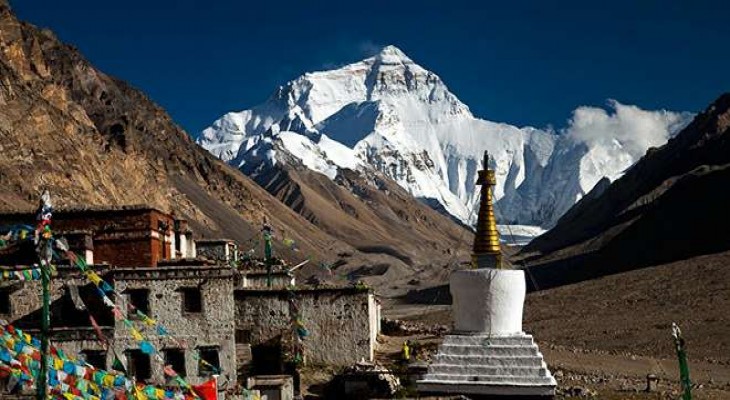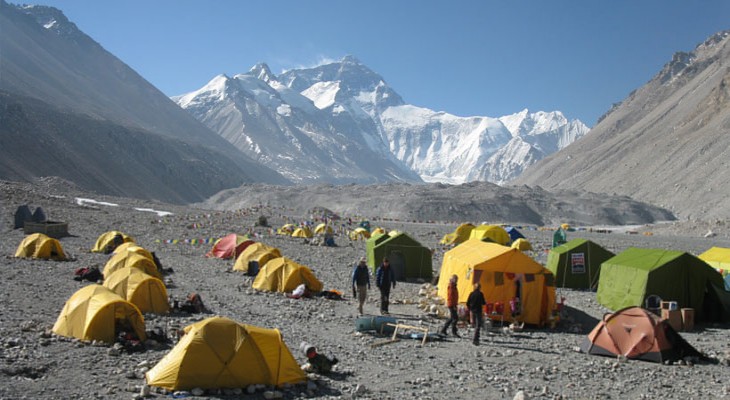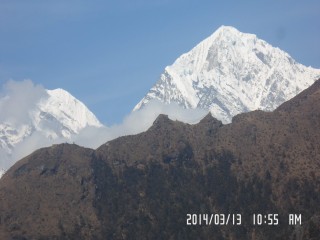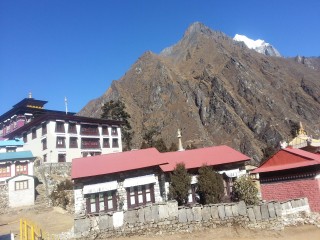Introduction
Tibet with Mount Everest Base Camp Tour is a very comprehensive tour of Tibet with visits to the cultural, historic and natural attractions of Tibet. The tour includes all the important places of interest in central & south Tibet including a visit to Rongbuk Monastery and Mt. Everest Base Camp. After flying into Lhasa from Kathmandu, Chengdu or Beijing, explore the cultural and historic sites of Lhasa, Shigatse and Gyantse. Afterwards drive overland in 4-WD jeeps across the Tibetan highlands and high passes to the fabled Rongbuk Monastery and Mt. Everest Base Camp from where the view of the great North face of Mount Everest is the most spectacular of all.
Outline Itinerary
Day 1 Fly from Kathmandu to Lhasa.
Day 2 Lhasa Sightseeing tour. You visit the Potala & Norbulinka Palace, Drepung & Sera Monastery, Jokhang Temple & the Barkhor Bazaar.
Day 3 Lhasa Sightseeing tour. You visit the Potala & Norbulinka Palace, Drepung & Sera Monastery, Jokhang Temple & the Barkhor Bazaar.
Day 4 Drive from Lhasa to Gyantse crossing The Kamba La(4794m.) and Karo La Pass (5010m.) via The Lake Yamdrok-Tso.
Day 5 Visit Khumbum Stupa & Phalkor Monastery at Gyantse.
Day 6 Drive from Shigatse to Tingri.
Day 7 Drive from Tingri to Rongbuk.
Day 8 Excursion to Everest Base Camp.
Day 9 Drive from Rongbuk to Nyalam.
Day 10 Drive downhill to Zhangmu and to Kathmandu.
Day 1 : Fly from Kathmandu to Lhasa.
Early morning transfer to the airport and board the plane for the flight over the Himalaya to Lhasa. If the weather is clear there is a wonderful view of Everest, Nuptse, Lhotse, Makalu, Kanchenjunga and other peaks en route. On arrival at Gonggar airport (which is 90 km. from Lhasa), you meet your vehicle and drive east along the broad Yarlung Tsangpo valley to Tsedang (3400m.). After checking in to your hotel, you drive south to see the oldest building in Tibet. The Yumbu Lakhang, a beautiful castle-like dwelling and monastery, dramatically perched on a spur looking out over the fertile valley below. If time permits you may be able to visit a small monastery close to Tsedang, or an interesting carpet factory where you can see the whole process of carpet making. Stay overnight at hotel.
Accomodation :
Day 2 : Lhasa Sightseeing tour. You visit the Potala & Norbulinka Palace, Drepung & Sera Monastery, Jokhang Temple & the Barkhor Bazaar.
One of the highlights is the visit to the symbol of Tibet; the Potala Palace set high on Red Hill, the winter home of the Dalai Lama until 1959. The most sacred temple in Lhasa is Lokhang, where people come from all over Tibet to visit and pray in this spiritual heart of the country. Another great treasure is the Norbulingka – the old summer palace of the Dalai Lama. Now you visit Jorkhang Temple, the center of the Tibetan Buddhism and the sacred land of Buddhist followers where innumerable pilgrims come for worship every day. The temple, built in 647, is the earliest wood-and-masonry structure still existing in Tibet. Surrounding the Jorkhang Temple is the bustling Barkhor Street which is the religious and social focus of Lhasa. Around the Barkhor there are numerous stalls selling all sorts of handicrafts: brightly coloured boots and fur-lined hats, silver and turquoise jewellery, rosaries, prayer flags and charms, as well as beautiful Tibetan carpets and all manner of ordinary household ware. Next you visit Sera monastery, which was created in 1419, has always been an important Buddhist seminary. As rose are planted everywhere in the monastery, it is also called “the court of wild rose”. Today still 200 lamas live in there. On the other hand, Drepung Monastery, is the world’s largest monastery with about 10,000 monks. Stay overnight at hotel.
Accomodation :
Day 3 : Lhasa Sightseeing tour. You visit the Potala & Norbulinka Palace, Drepung & Sera Monastery, Jokhang Temple & the Barkhor Bazaar.
One of the highlights is the visit to the symbol of Tibet; the Potala Palace set high on Red Hill, the winter home of the Dalai Lama until 1959. The most sacred temple in Lhasa is Lokhang, where people come from all over Tibet to visit and pray in this spiritual heart of the country. Another great treasure is the Norbulingka – the old summer palace of the Dalai Lama. Now you visit Jorkhang Temple, the center of the Tibetan Buddhism and the sacred land of Buddhist followers where innumerable pilgrims come for worship every day. The temple, built in 647, is the earliest wood-and-masonry structure still existing in Tibet. Surrounding the Jorkhang Temple is the bustling Barkhor Street which is the religious and social focus of Lhasa. Around the Barkhor there are numerous stalls selling all sorts of handicrafts: brightly coloured boots and fur-lined hats, silver and turquoise jewellery, rosaries, prayer flags and charms, as well as beautiful Tibetan carpets and all manner of ordinary household ware. Next you visit Sera monastery, which was created in 1419, has always been an important Buddhist seminary. As rose are planted everywhere in the monastery, it is also called “the court of wild rose”. Today still 200 lamas live in there. On the other hand, Drepung Monastery, is the world’s largest monastery with about 10,000 monks. Stay overnight at hotel.
Accomodation :
Day 4 : Drive from Lhasa to Gyantse crossing The Kamba La(4794m.) and Karo La Pass (5010m.) via The Lake Yamdrok-Tso.
Today is a full day picturesque drive crossing over a colorful Yamdrok Lake, Kambala Pass at 4,794 m and Karola Pass at 5,010m. In Gyantse you spend time visiting the Pelke Chode Monastery and Kumbum stupa in Gyantse before driving through a landscape of fields and low hills of Shigatse, Tibet’s second largest town at 3,900m. Shigatse is situated near the junction of the Ngang and Yarlung Tsangpo (Brahmaputra) rivers, with many traditional low ceiling, flat roofed, mud brick Tibetan houses, but quite a lot of ugly modern Chinese buildings as well. It is home of the Tashilunpo monastery, traditional seat of the Panchen Lama, and one of the great centers of Tibetan Buddhism. Shigatse also has an interesting bazaar, where various traditional items can often be found at more or less reasonable prices. Shigatse has always been an important trade and administration center and also has political and religious significance, once being the seat of the Panchen Lama. The town is essentially divided into two parts: the old Tibetan style area in the city and the concrete, modern Chinese part of the town. The older streets and alleys here are very pleasant to wander and there are a few sights of interest to warrant a stay of a day or two. Stay overnight at hotel.
Accomodation :
Day 5 : Visit Khumbum Stupa & Phalkor Monastery at Gyantse.
Proceed to Shigatse to visit the Tashilunpo Monastery and the free market. Gyantse lies at the head of the Nyangchu Valley astride the main trade routes from India, Bhutan, and Nepal to Lhasa. Made wealthy by selling sheep and yak wool, the rich lords of the city pooled their resources in the early 1400’s to build the Kumbum, a Nepalese-style stupa containing some of the best preserved and most unique art in Tibet, and Phalkor Chode Monastery, the spectacular assembly hall. In the 15th century, there were actually nine major monasteries near or in the town. In 1904, Younghusband, leader of the British expedition to Lhasa, waged a major battle, killing several hundred Tibetans. He stayed on for a month in the castle, before proceeding to Lhasa. The Kumbum is truly the synthesis of Nepali (Newari)/Tibetan art and architecture. The building itself contains 112 chapels each with spectacular statues and paintings in remarkably good repair. As one moves from the lower to the higher stories, the wall paintings themselves represent higher and higher Buddhist practices. You will also visit the Phalkor Chode Monastery at the other end of town. The monastery was built in 1418 by Rabten Kunzang. Excellently preserved, the monastery contains many statues and paintings that date back to its founding. Without doubt, the statues, paintings and thankas of Gyantse are among some of the most spectacular art of the trip. You will continue driving west to Shigatse. In the early days of Communism, some of the monks of Shigatse were in collusion with the security bureau and reported anyone accepting or distributing pictures of the Dalai Lama. They hoped that by cooperating with the Communists, they could save their temple from destruction. Sadly, it did not work completely. Nevertheless, Tashilumpo Monastery, the oldest and largest Gelugpa Monastery in Tsang province and home to the Panchen Lama, is lovely, and your kora or pilgrim circuit, will take you past holes for dogs, thought of as “fallen monks,” as well as places to earn merit by rubbing our bodies against holy rocks. We will also have time to explore the bazaar. Stay overnight at hotel.
Accomodation :
Day 6 : Drive from Shigatse to Tingri.
Your trip today takes you to Tingri, the trekkers’ gateway to Mount Everest. The name of this windblown settlement comes from the sound made by a special black rock, thrown all the way from India to Tibet by an incarnation of the Buddha, when the rock struck the ice near the present site of the town. Stay overnight at hotel.
Accomodation :
Day 7 : Drive from Tingri to Rongbuk.
Drive over Pangla pass to Rongbuk Monastery situated below the giant North Face of Mt. Everest. Stay overnight at hotel.
Accomodation :
Day 8 : Excursion to Everest Base Camp.
Two hours trek from The Rongbuk Monastery will lead you to the base of the highest peak on Earth The North Face of Mount Everest (8848m.) Or Mount Quomolangma in Tibetan. Explore the base camp and The Ronghu Glacier. But the views are stupendous on a clear day, and feature a huge sweep of the Himalaya range including peaks over 8000, Makalu, Lhotse, Everest, Gyachung and Cho Oyu. When you finally get to Base Camp, the first sight of the mighty Everest simply leaves you speechless. Stay overnight at hotel.
Accomodation :
Day 9 : Drive from Rongbuk to Nyalam.
Drive downhill to Nyalam crossing two spectacular passes- The Lalung La (5082m.) and Nyalam Pass (3800m.). Stay overnight at hotel.
Accomodation :
Day 10 : Drive downhill to Zhangmu and to Kathmandu.
On this, your last day in Tibet, you will descend to Zangmu or Khasa, some 560 miles from the beginning of our journey in Lhasa. Today you will take the plunge, dropping 15,000' to the lowest point in the Sun Kosi valley. After completing all Chinese customs procedures, depending on the state of the road, you will either walk or drive to the Nepal border, cross customs, and continue on to Kathmandu. On this, your last day in Tibet, you will descend to Zangmu or Khasa, some 560 miles from the beginning of our journey in Lhasa. Today you will take the plunge, dropping 15,000' to the lowest point in the Sun Kosi valley. After completing all Chinese customs procedures, depending on the state of the road, you will either walk or drive to the Nepal border, cross customs, and continue on to Kathmandu.
Accomodation :





